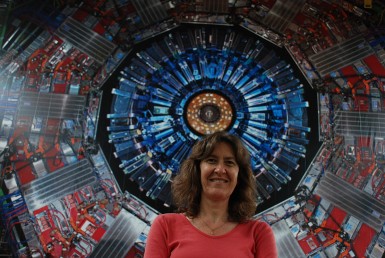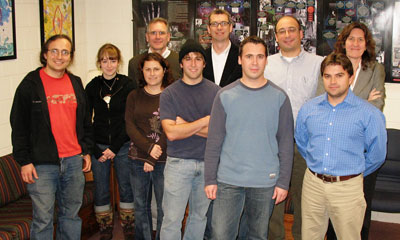UIC’s helping hands put Higgs particle within scientists’ grasp

“The next big challenge is to understand the characteristics of the particle,” says physics professor Cecilia Gerber. A team of UIC physicists joined thousands of physicists from around the world in the Higgs search.
You can’t see it, but information gleaned from trillions of smashed atoms suggests it’s really there: the elusive subatomic particle called the Higgs boson, deemed essential to the physical workings of our universe.
Newly analyzed data that adds proof of the Higgs’ existence was presented July 4 at CERN — the European Organization for Nuclear Research — in Geneva, Switzerland, home of the world’s largest particle collider.
Several UIC faculty members joined colleagues from around the world in sharing credit for hunting down the particle.
“We live in one of the most exciting times in the history of humankind,” said Richard Cavanaugh, assistant professor of physics, “an epoch in which we are not only privileged to ask, but also to answer fundamental questions about the extremes of our existence — from the origin of the universe to its present-day state and even to its ultimate fate.”
The particle is named for British physicist Peter Higgs, who with other physicists developed what’s called the Standard Model to explain why some particles have mass and other don’t.
The model makes the Higgs responsible for generating mass for fundamental particles. Physicists say that without the Higgs boson, everything in the universe would be like free-floating particles of light, never combining to create matter.
Higgs, 83, a retired physics professor at Edinburgh University who was in Geneva for the announcement, told reporters it was “certainly a long wait” but “very nice to be right sometimes.”
Many physicists believe the new boson particle almost certainly is the Higgs, but its technical properties must be defined to nail down the confirmation.
Two-decade search
While its existence was first predicted in the mid-1960s, the search for the Higgs began in earnest about two decades ago at CERN. It shifted 10 years ago to the giant Tevatron particle collider at Fermi National Accelerator Laboratory in west suburban Batavia.
When Tevatron shut down a year ago, the bulk of atom-smashing activity moved back to CERN at its new, more powerful Large Hadron Collider, or LHC.
UIC physicists have worked on experiments at both colliders, which generate energy conditions comparable to the “Big Bang” moment some 14 billion years ago.
Physicists from UIC’s particle and nuclear physics groups worked on a CERN experiment called the Compact Muon Solenoid, or CMS. It analyzed LHC proton collisions for signs of fleeting Higgs particles within a mass range measured by electron volts.
Two days before CERN announced its findings, Fermilab presented its final results from more than a decade of data analyzed after some 500 trillion Tevatron particle collisions. The Fermilab researchers also found strong indications that the Higgs exists.

Back row (from left): Mark Adams, Richard Cavanaugh, Nikos Varelas, Cecilia Gerber. Front row (from left): Mario Camuyrano, Lucie Gauthier, Ioana Anghel, Chris Silkworth, Cosmin Dragoiu, Samvel Khalatian.
Physics professor Mark Adams said UIC faculty started “very persistent Higgs efforts” at Fermilab in the late 1980s.
“Since we joined CMS in 1995, our group helped build several parts of the detector and we have performed analyses in many areas, many contributing to understanding of the backgrounds for the Higgs searches,” he said.
Adams, professor Nikos Varelas and Cavanaugh were at Fermilab in the wee hours of July 4 to hear the Geneva announcement. Cavanaugh, an active member of the CMS experiment, helped organize the event, which attracted hundreds of scientists, students and friends to Fermilab.
Varelas, who has worked on Tevatron’s DZero experiment since 1994 and served two years as its Higgs group convener, was at CERN just before the July 4 announcement to help finalize the CMS results. He, along with research assistant professor Len Apanasevich, graduate assistant Inga Bucinskaite and former doctoral student Cosmin Dragiou, spent much of the past year analyzing Higgs data under a grant from the National Science Foundation.
The real thing, or a sibling?
Varelas agreed the latest results suggest that the particle is the elusive Higgs, but added, “more data and further studies are needed to characterize the particle’s properties … and exclude the possibility of it being a Higgs-like sibling predicted from a new ‘super theory.'”
Techniques developed by UIC physics professor Cecilia Gerber to analyze results of particle collisions at Fermilab were used to help find the Higgs.
“The next big challenge is to understand the characteristics of the particle we found,” said Gerber, who was in Geneva July 4 for the announcement.
“Finding it already disproved several theories of how mass originates, but only understanding in detail the properties of the particle we found will allow us to fully understand how matter in the universe acquires mass.”
Varelas called the finding historic.
“It might be a bridge to more exciting discoveries that may help us understand the fundamental workings of our universe,” he said.
“I’ve been on the hunt for the Higgs boson for more than a decade (and) am thrilled to have been part of this discovery.”
Like other physicists, however, Varelas believes that even more challenging work lies ahead to characterize the finding.
“Now the fun begins!” he said.
